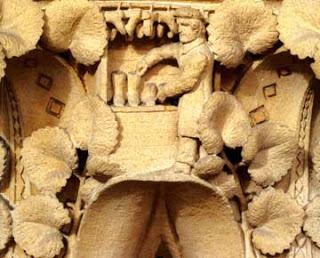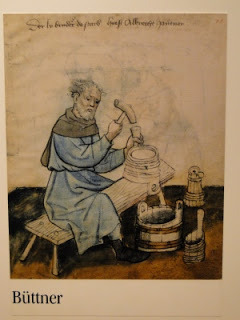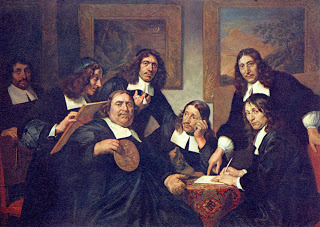The Creation of a Master-piece - Guilds in England
 From the 14th century right up until the 18th century in England, no master-craftsman could set up in a particular craft unless he became a member of its Guild.
From the 14th century right up until the 18th century in England, no master-craftsman could set up in a particular craft unless he became a member of its Guild. So what were these Guilds that had such a stranglehold on craftsmanship and production?
The Guilds were controlled by a self-elected oligarchy, or confraternity of craftsmen, a system greased by bribery and favouritism.
Above, a bootmaker from Northampton shows his wares.
Guild Laws restricted a man to the manufacture of only one article, for example weavers were not allowed to dye their cloth, shoemakers were not permitted to mend shoes and bowyers could not make arrows for their bows, only the fletchers could do that. This was supposedly to protect each craftsman's job, but in practice led to much dispute and difficulty.
If you became a member of a Guild you would have to make your goods from specified materials, employ a specified number of apprentices, and sell at the Guild's fixed prices. If you failed to do this, or produced shoddy goods or work not approved by the Guild you would face penalties such as a fine, punishment in the pillory or imprisonment. Each Guild had a Court, and cases not satisfied in the Court would go before the Mayor who would arbitrate.

Only freemen of a particular town could join the Guild for their craft. Even if you had been a Guild member in another town, you still had to serve 5 years bound to a recognised master in the new town before you could prove yourself by making your "master-piece" and finally being admitted to join.
No one was allowed to sell their goods by candlelight, in case of passing off faulty workmanship under cover of darkness, and no work could be done after eight o'clock Saturday night until Monday morning, to respect the Sabbath.
Guilds were social as well as business institutions, and concerned themselves with the welfare of their workers and founded schools and alms-houses, even occasionally in some crafts supplying dowries for poorer women workers. Each Guild had its own Chaplain to conduct the services, and its own patron saint - St Anthony for grocers, St Patrick for saddlers, St Clement for tanners, St Stephen for weavers, and so forth.

Crafts were highly specialised, there were Guilds of longbow-string makers, salters, horners, patten makers, quilters and pin makers. Above you can see the Guild of Painters, of 1695. As you can see they are all dressed alike. Each Guild had its own costume, with variations for the different ranks. Apprentices wore blue cloaks in the winter and blue gowns in the summer. Nobody was allowed to wear cloaks below calf-length until they reached old age.Many of England's finest buildings are the Guild Halls quite a few of which survive. The one pictured is Leicester's Guild Hall, a fine Elizabethan example.

"a haberdasher and a carpenter,A webber, dyer and a papicerWere with us eke, clothed in a liveryOf a solemn and great fraternity. Full fresh and new their gear apyked was,Their knives were ychaped not with brass,but all with silver wrought full clean and weel.Their girdles and their puches every deal.Well seemed each of them a fair burgessTo sitten in a Guild Hall on a dais"Chaucer
Published on November 17, 2011 02:07
No comments have been added yet.



